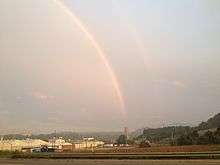Enka, North Carolina


Enka is an unincorporated community in Buncombe County, North Carolina, United States. It lies on U.S. Routes 19, 23, and 74 Business near the interchange of Interstates 26, 40, and 240. Although it is unincorporated, it has a post office, with the ZIP code of 28728.[1]
American Enka
The American Enka Company, incorporated in 1928,[2] built what became the nation's largest rayon-producing factory. The Dutch name of the rayon company was Nederlandse Kunstzijdefabriek, and it is from the Dutch phonetic pronunciation of the initial letters N and K of the firm's name that "Enka" is derived. The alternative explanation that Enka stands for "Eerste Nederlandse Kunstzijdefabriek Arnhem" is incorrect.[3] The Dutch company considered many sites and decided on the Hominy Valley because of its supply of water and labor.[4] In 1929 the company began developing a community plan that included employee houses and became known as Enka Village. Enka Village is now a historic community and is part of the city of Asheville.
American Enka bought 2000 acres and built a $10 million plant. 1900 people worked there during the Great Depression, and that number reached 4300 after World War II. At one point 7000 people worked there. Amenities included a gym, a pool room, a bowling alley, two cafeterias and a library. Enka Lake Club opened on a lake built to supply the plant with water. Buses delivered employees from the surrounding area.[4]
It was said that stricter environmental regulations led to a decline in rayon, and American Enka sold the plant to BASF in 1985. BASF sold the plant to Colbond Inc. in 2000, and as of 2007, rayon was no longer made. The northern section was sold to developers who tore down everything but the clock tower. Enka Lake became Biltmore Lake, part of Biltmore Farms, and three buildings became the Enka campus of Asheville–Buncombe Technical Community College.[4]
The future of Enka
On July 6, 2010, the city of Asheville began looking at a proposal for Enka Center, which will take an estimated 14 years to complete. The clock tower of the former American Enka plant would be the centerpiece of a retail center on the northwest section of the 192-acre (0.78 km2) site. Portions of the plant still stand, including a campus of Asheville-Buncombe Technical Community College; these would remain. Offices, warehouses and industrial areas would locate in the southeastern part of the complex. 29 acres (120,000 m2) would remain open space, and a greenway would follow along Hominy Creek.[5]
Though as of 2015 about 200 people worked for Bonar Inc. making fabric for commercial carpet backing, and more space was leased to ten other companies, most of the former plant is gone. A school scheduled to open in 2016 will have 20,000 bricks from the plant, a clock tower recalling the one at the plant, and sloped roofs recalling the sawtooth design.[4]
References
- ↑ Zip Code Lookup
- ↑ "The story of American Enka", Ties, Southern Railway, October 1961
- ↑ "Audiovisueel materiaal - Historisch Museum Ede". Retrieved 2010-07-13.
De naam ENKA is de fonetische uitspraak van de 'N' en de 'K', de afkorting van de volledige fabrieksnaam. De verklaring dat 'ENKA' zou staan voor de 'Eerste Nederlandse ENKA-fabriek [ca. 1926] Kunstzijdefabriek Arnhem' is niet correct. Vervolgens heeft deze firma meerdere naamsveranderingen ondergaan.
- 1 2 3 4 "New Enka school looks to past". Asheville Citizen-Times. 2015-06-21.
- ↑ Barrett, Mark (2010-07-07). "Large shopping and business center proposed in Enka". Asheville Citizen-Times. Retrieved 2010-07-13.
External links
- Enka at the U.S. Geographic Names Information System
Coordinates: 35°32′59″N 82°39′00″W / 35.5498322°N 82.6501279°W